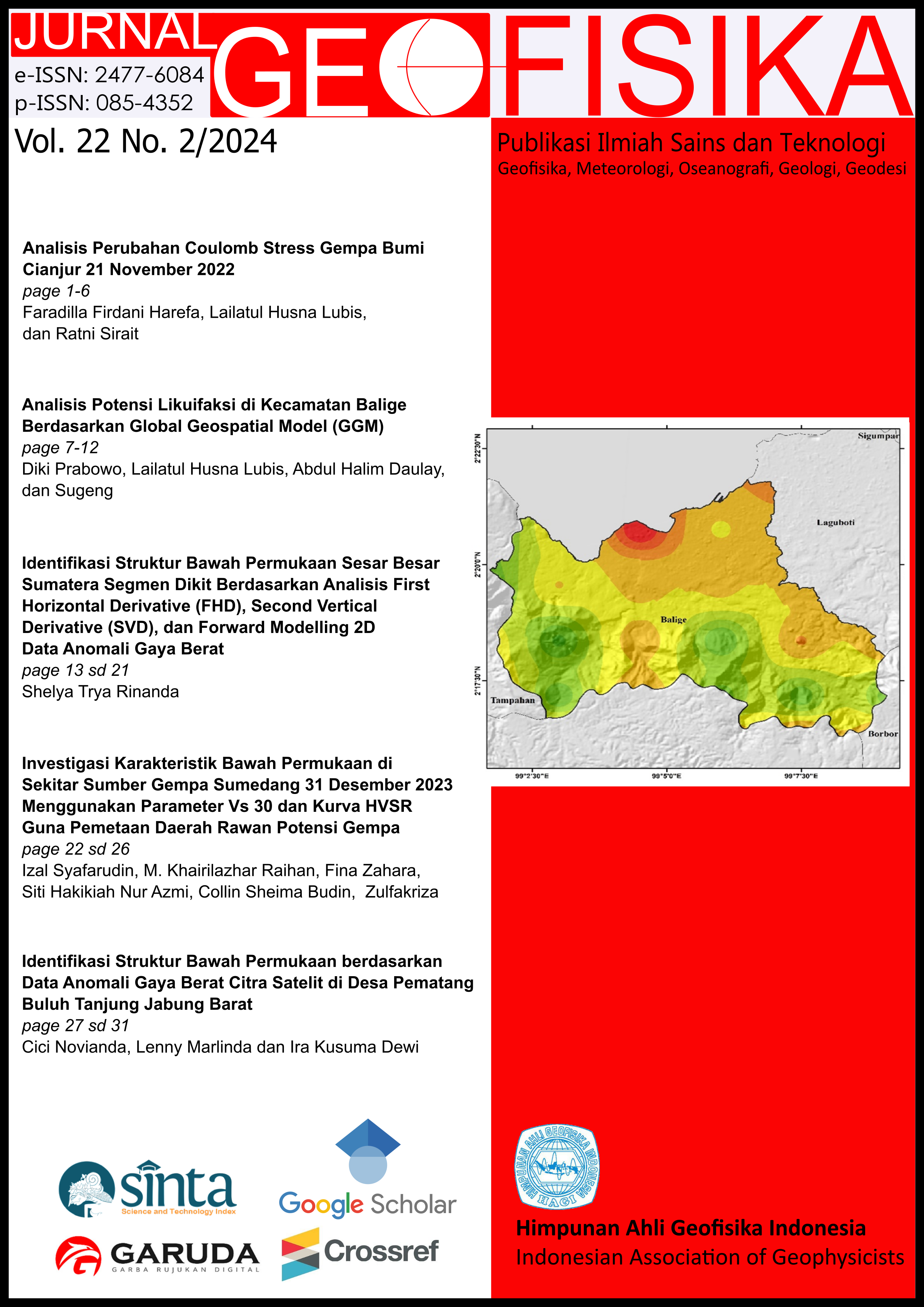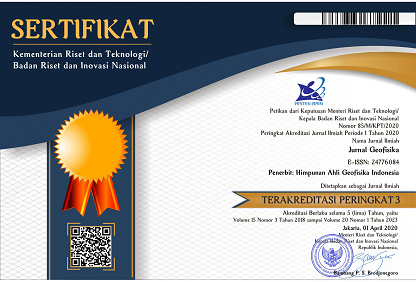Analisis Perubahan coulomb stress Gempa Bumi Cianjur 21 November 2022
Keywords
gempa bumi, Sesar Cugenang, perubahan coulomb stressAbstract
The earthquake that occurred in Cianjur Regency on November 21, 2022 with a magnitude of 5.6 Mw had a huge impact, including casualties and meterial damage. The location of the earthquake based on data sourced from BMKG was at -6.870° N and 107.016° E and the earthquake occurred due to the Cugenang fault. After the 5.6 Mw earthquake was followed by a series of aftershocks. The purpose of this study was to determine the effect of coulomb stress changes on the Cianjur earthquake and the direction of aftershock distribution using the coulomb stress method. The results of this study show the effect of coulomb stress on earthquakes in Cianjur Regency forming 8 lobes. 4 red lobes that mean an increase in stress, namely (north direction is in Cipanas and Pacet sub-districts, east direction is in Cugenang sub-district, south direction is in Cireunghas sub-district, and southwest to west direction is in Cikole sub-district) with a value of 0 to 0, 2 bar and 4 blue lobes indicating a decrease in stress, namely (northeast direction in Sukaresmi sub-district, southeast direction in Warungkondang, Cibeber and Cilaku sub-districts, southwest direction in Sukaraja, Sukabumi and Sukalarang sub-districts, and west to northwest direction in Nagrak, Kadudampit and Caringin sub-districts) with a value of 0 to -0.2 bar. The distribution of aftershocks was more in Cugenang sub-district and partly in Warungkondang sub-district.
References
Amran, Y. Kurniawan, D. (2017): Perencanaan dinding penahan tanah sungai way batanghari kota metro
dengan metode revetment retaining wall. TAPAK (Teknologi Aplikasi Konstruksi), 6(2), 157–167, doi:http://dx.doi.org/10.24127/tapak.v6i2.424.
BMKG (2023): Dukungan bmkg dalam percepatan rehabilitasi dan rekonstruksi rumah terdampak bencana gempa bumi cianjur. https://www.bmkg.go.id/artikel/?p=43254&lang=ID.
BNPB (2022): Kerusakan bangunan akibat gempa bumi m 5,6 cianjur. https://bnpb.go.id/berita-foto/
kerusakan-bangunan-akibat-gempabumi-m5-6-cianjur.
Bujung, C.A. (2020): Studi densitas lineament dan pola aliran permukaan daerah manifestasi geotermal di sekitar
danau tondano. FISTA Jurnal Fisika dan Terapannya, 1(1), 1–5,doi:https://doi.org/10.53682/fista.v1i1.55.
Mala, H.U. Mohamad, J.N. (2020): Arah penyebaran stress coulomb pada batuan akibat gempabumi kairatu
26 september 2019. Jurnal Wahana Fisika, 5(1), 62–70, doi:https://doi.org/10.17509/wafi.v5i1.24500.
Murtianto, H. (2010): Potensi kerusakan gempa bumi akibat pergerakan patahan sumatera di sumatera
barat dan sekitarnya. Jurnal Geografi GEA, 10(1), doi:https://doi.org/10.17509/gea.v10i1.1667.
Mustafa, B. (2010): Analisis gempa nias dan gempa sumatera barat dan kesamaannya yang tidak menimbulkan
tsunami. Jurnal Ilmu Fisika, 2(1), 44–50, doi:10.25077/jif.2.1.44-50.2010.
Pamungkas, D.A. (2019): Identifikasi mekanisme fokus dan intensitas getaran tanah maksimum gempabumi Lombok tanggal 29 juli – 1 oktober 2018. Bachelor’s thesis, Universitas Islam Negeri Maulana Malik Ibrahim.
Pangastuti, N.P.J., Suarbawa, K.N., Putra, I.K. Purnami, N.L.D. (2021): Analysis of earthquake potential energy in
the bali subduction zone. Buletin Fisika, 23(2), 137–144, ISSN 2580-9733,doi:10.24843/BF.2022.v23.i02.p09.
Qothrunnada, N.H., Utami, R.Y. Rizky, S.A. (2022): Menganalisis bencana alam gempa bumi dalam perspektif alquran. Prosiding Konferensi Integrasi Interkoneksi Islam dan Sains, 4, 257–260.
Rahim, A., Nurjamillah, I., Hafidah, I., Fauzy, M.N. Alhaqni, Z.P. (2023): Penerapan trauma healing untuk mengatasi kecemasan pada anak pasca bencana gempa bumi di sekolah dasar negeri mekarjaya cianjur. Jurnal Abdimas Bina Bangsa, 4(1), 199–203,doi:10.46306/jabb.v4i1.357.
Rahmawati, W. Madlazim (2021): Analisis distribusi tegangan normal gempa bumi di wilayah sesar sumatera menggunakan metode inversi tegangan. Inovasi Fisika Indonesia, 10(2), 73, doi:https://doi.org/10.26740/ifi.v10n2.p73-80.
Sinaga, G.H.D. (2016): Analisis Coulomb Stress Gempa Bumi Halmahera Barat MW=7,2 terhadap Aktivitas Vulkanik Gunung Soputan dan Gunung Gamalama. Master’s thesis, Universitas Sumatera Utara.
Siwi, P.W., Sriyanto, S.P.D., Rondonuwu, A.T. Silangen, P.M. (2020): Perubahan coulomb
stress akibat gempa bumi laut maluku 7 januari 2019. Jurnal Geosaintek, 6(3), 137–142, doi:http://dx.doi.org/10.12962/j25023659.v6i3.7030.
Supartoyo dkk. (2023): Bumi Cianjur Berguncang: Geologi Menyelidiki dan Memitigasi. Badan Geologi, Kementerian Energi dan Sumber Daya Mineral, ISBN 978-602-9105-940.
Ummah, K.F. Madlazim (2021): Analisis distribusi tegangan normal gempa bumi di sekitar sesar
sorong-yapen (papua) menggunakan metode inversi tegangan. Inovasi Fisika Indonesia, 10(2), 33–39,
doi:https://doi.org/10.26740/ifi.v10n2.p33-39.
Viorensi, H.I., Limehuwey, R. Sahara, D.P. (2023): Evaluasi perubahan tegangan coulomb dan implikasinya terhadap bahaya seismik di provinsi maluku. Tanah Goyang, 1(1), 38–50.
Wardani, N.N.S.K., Suarbawa, K.N. Kusnandar, R. (2021): Determination of fault type of lombok earthquakes
from july 1 to december 31, 2018, using focal mechanism method. Buletin Fisika, 22(2), 91 – 96, doi:https://doi.org/10.24843/BF.2021.v22.i02.p06.
Zakaria, Z. (2008): Identifikasi kebencanaan geologi kabupaten cianjur, jawa barat. Bulletin of Scientific
Contribution, 6(1), 44–56, ISSN 1693-4873, doi:https://doi.org/10.24198/bsc“%20geology.v6i1.81589.

This work is licensed under a Creative Commons Attribution 4.0 International License.
The copyright of all articles belongs to the authors. All other copyrights is held by the Journal











